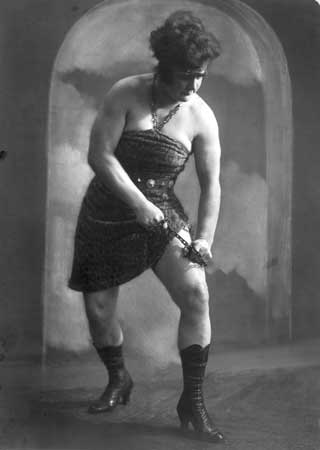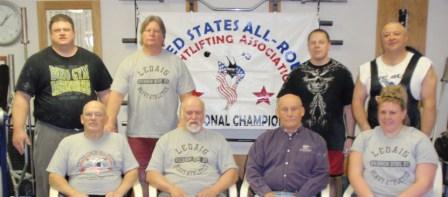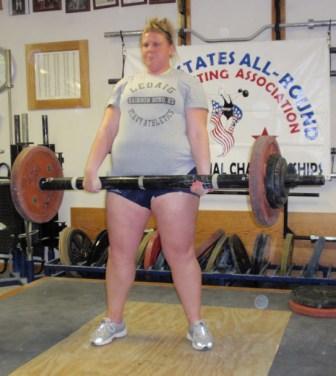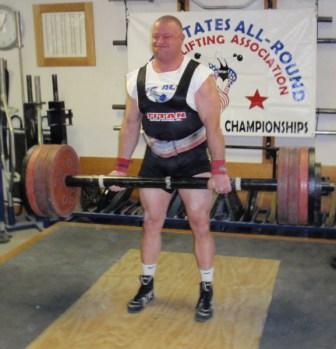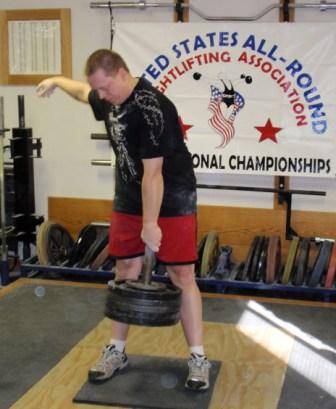by Al Myers
DINO GYM RECORD DAY
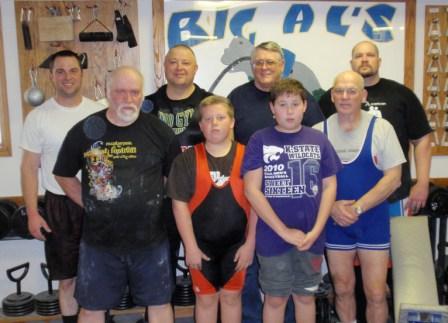
Group picture of the lifters at the 2011 Dino Gym Record Day. Pictured front row (left to right): Mike Murdock, Chris Krenzin, Tyler Krenzin, Denny Habecker. Back row (left to right): Casey Barten, Al Myers, LaVerne Myers, Scott Tully. Not pictured: Chuck Cookson, Tyeler Cookson, Matt Cookson
MEET REPORT
After the great meet the day before at the Grip Championships, I wondered if anyone had the energy and motivation to come back for “Day Two” to set some USAWA records. I was surprised to have 11 participants! Lots of records were set. One of the first to walk in the door of the Dino Gym was Mike Murdock. When I was checking Mike in, he informed me that there was a change to his “status” – he NOW was 71 years old instead of 70, as today was his birthday! What a way to spend your birthday – breaking records in the USAWA! Mike went on to break more records than anyone else with a total of 20. That’s a lot of records considering Mike was going all-out on every lift. His 80# Crucifix impressed me the most – considering it was done IMMEDIATELY following his dumbbell clean and press.
The Krenzin brothers have been regulars these past few years at my record days. These two young kids, Chris and Tyler, keep getting stronger as they grow. They enjoy breaking the marks in lifts that they did the YEAR BEFORE the most. Their one arm VB deadlifts were very impressive. Tyler did 100# and Chris was close behind at 97#. It impressed me when Chris noticed I was wearing my lifting singlet he went back out to the truck to get his youth wrestling singlet – and then he put it on! He wanted to look like a weightlifter too!!
Scott Tully had a great day. The day before Scott served as the head official of the Grip Championships. Based on the grip records he set in this record day – he should have been competing! Scott performed a 358# Fulton Bar Ciavattone Grip Deadlift, a 232# one arm 2″ VB deadlift, and a 414# 2 bar 2″ VB deadlift – all for overall records in the 125 plus kilogram class. Pretty stupendous lifts!!! He topped off his day by breaking the record in the hands together bench press with a lift of 320#, erasing the record held by the Bench Behemoth Dave Beversdorf. (I’m just throwing this out Dave to give you a little motivation!!)
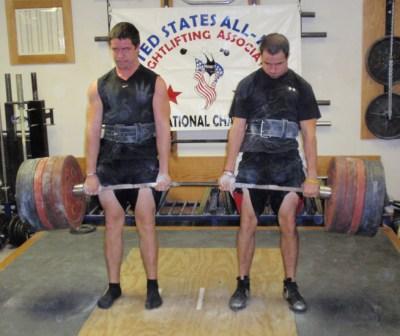
Matt and Tyeler Cookson pulled a 2-Man Team Deadlift of 860 pounds, for the highest USAWA Team Deadlift of All-Time amongst Junior lifters.
My Dad LaVerne was planning to sit this one out like he did the day before because of a recent eye surgery. But like a true all-rounder, he decided to ignore the doctors recommendations and “just lift light” instead. However, once he got started the lifts he did just kept getting heavier and heavier! His lift that impressed me the most was his 77# one hand Pinch Grip.
Denny Habecker made the long drive to my place by himself (over 20 hours) and still had the energy to lift both days, and on top of that, set many records on Sunday. His record count for the weekend had to be over 15. All I can say is “Poor Art” because Denny has just padded his lead in the Records Race over Art Montini. Denny did a wide range of record lifts, from presses to deadlifts. Denny doesn’t have any weak areas that he can’t set records in.
Dino Gym member Casey Barten just came in for a Sunday afternoon training session and ended up setting a few records. Casey always trains Sunday afternoons, and is usually training by himself. He wasn’t really planning to do anything but I gave him some encouragement (like saying “don’t be a sissy”) and so he added some USAWA records to his Sunday afternoon training session.
It was mid-afternoon (and everyone was getting worn out) and I thought the record day might be done, but in walks Chuck Cookson and his two sons, Tyeler and Matt. We didn’t know it at the time – but the show was just beginning!! Matt, at only 16 years of age, deadlifted with a 12 inch base 484#. Brother Tyeler showed him big brother still was stronger and pulled 507# the same way. However, Big Poppa Chuck let the boys know “who their daddy was” and pulled 661# with a 12″ base!! Only multiple time Mr. Olympia Ronnie Coleman has done more in the USAWA with a 728# 12 inch base DL at the 1994 Texas Deadlift Classic. Matt and Tyeler then joined forces in TEAM lifting and set several two man records. Their Team Cheat Curl of 330# was very impressive, along with their Team Deadlift of 860#.
I want to thank everyone who attended this year’s Dino Gym Record Day. Participation is what makes these events fun. Sorry for the short meet report, but I got LOTS of results to enter!!!
MEET RESULTS
Dino Gym Record Day
February 13th, 2011
Dino Gym, Holland, Kansas
Meet Director: Al Myers
Certified Officials (1-official system used on all lifts): Al Myers, Denny Habecker, Scott Tully, Mike Murdock
Chris Krenzin – Age 10, BWT 157# (Age group 10-11, Class 75K)
Vertical Bar Deadlift – 1 bar, 2″, right hand: 97#
Vertical Bar Deadlift – 1 bar, 2″, left hand: 92#
Deadlift – Ciavattone Grip: 140#
Curl – Strict: 35#
Clean and Press – 2 Dumbbells: 40#
Tyler Krenzin – Age 13, BWT 146# (Age group 12-13, Class 70K)
Vertical Bar Deadlift – 1 bar, 2″, right hand: 100#
Vertical Bar Deadlift – 1 bar, 2″, left hand: 82#
Deadlift – Ciavattone Grip: 140#
Curl – Strict: 30#
Clean and Press – 2 Dumbbells: 20#
Matt Cookson – Age 16, BWT 187# (Age group 16-17, Class 85 K)
Deadlift – 12″ Base: 484#
Tyeler Cookson – Age 19, BWT 172# (Age group 18-19, Class 80 K)
Deadlift – 12″ Base: 507#
Tyeler Cookson & Matt Cookson (Age group 18-19, Class 85 K)
Team Curl – Cheat: 330#
Team Deadlift: 860#
Team Clean and Jerk: 352#
Team Clean and Press: 308#
Casey Barten – Age 30, BWT 180# (Age group 20-39, Class 85K)
Lateral Raise – Standing: 70#
Deadlift – Inch Dumbbell, Right Arm: 105#
Deadlift – Inch Dumbbell, Left Arm: 105#
Scott Tully – Age 35, BWT 343# (Age group 20-39, Class 125+K)
Bench Press – Hands Together: 320#
Deadlift – Fulton Bar, Ciavattone Grip: 358#
Press – From Rack: 250#
Pinch Grip – Left Hand: 77#
Swing – Dumbbell, Left Arm: 100#
Snatch – Dumbbell, Left Arm: 105#
Vertical Bar Deadlift – 1 Bar, 2″, Right Hand: 232#
Vertical Bar Deadlift – 2 Bars, 2″: 414#
Lateral Raise – Standing: 80#
Chuck Cookson – Age 41, BWT 271# (Age group 40-44, Class 125 K)
Deadlift – 12″ Base: 661#
Press – From Rack, Behind Neck: 225#
Push Press – From Rack: 225#
Press – From Rack: 245#
Curl – Dumbbell, Cheat, Right Arm: 80#
Clean and Press – 2 Dumbbells, Heels Together: 210#
Al Myers – Age 44, BWT 250# (Age group 40-44, Class 115K)
Deadlift – 2 Inch Dumbbells: 240#
Clean and Press – Fulton Bar: 220#
Snatch – Fulton Bar: 185#
Clean and Press – 12″ Base: 220#
Snatch – From Hang: 187#
Swing – Dumbbell, Right Arm: 140#
Bench Dip: 230#
LaVerne Myers – Age 66, BWT 250# (Age group 65-69, Class 115K)
Deadlift – Inch Dumbbell, Right Arm: 120#
Deadlift – Inch Dumbbell, Left Arm: 120#
Crucifix: 40#
Deadlift – Fulton Bar, Right Arm: 141#
Deadlift – Fulton Bar, Left Arm: 141#
Holdout- Lowered: 30#
Holdout – Raised: 30#
Deadlift – No Thumb, Left Arm: 154#
Pinch Grip – Right Hand: 62#
Pinch Grip – Left Hand: 77#
Snatch – Left Arm: 55#
Snatch – Right Arm: 55#
Denny Habecker – Age 68, BWT 191# (Age group 65-69, Class 90K)
Crucifix: 50#
Press – Dumbbell, Right Arm: 70#
Press – Dumbbell, Left Arm: 60#
Clean and Jerk – Dumbbell, Right Arm: 85#
Clean and Jerk – Dumbbell, Left Arm: 65#
Snatch – Left Arm: 55#
Swing – Dumbbell, Right Arm: 65#
Deadlift – Dumbbell, Left Arm: 175#
Deadlift – Dumbbell, Right Arm: 175#
Bench Dip: 135#
Press – From Rack: 135#
Mike Murdock – Age 71, BWT 236# (Age group 70-74, Class 110K)
Vertical Bar Deadlift – 1 Bar, 2″, Right Hand: 127#
Holdout – Raised: 40#
Clean and Press – 2 Dumbbells, Heels Together: 80#
Crucifix: 80#
Clean and Press: 132#
Snatch – Dumbbell, Right Arm: 55#
Snatch – Dumbbell, Left Arm: 55#
Pinch Grip – Left Hand: 62#
Swing – Dumbbell, Left Arm: 60#
Swing – Dumbbell, Right Arm: 60#
Snatch – From Hang: 95#
Clean and Press – On Knees: 95#
Snatch – Left Arm: 55#
Snatch – Right Arm: 55#
Deadlift – Dumbbell, Left Arm: 145#
Deadlift – Inch Dumbbell, Right Arm: 90#
Deadlift – Inch Dumbbell, Left Arm: 105#
Vertical Bar Deadlift – 2 Bars, 2″: 224#
Bench Dip: 65#
Lateral Raise – Standing: 60#
